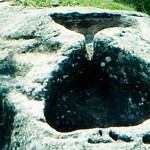THE EXTRAORDINARY WINES OF
BODEGAS CASTELL D’ENCUS
I first heard about Bodegas Castell D’Encus, DO Costers del Segre, via a Tweet from Pancho Campo. Señor Campo was Spain’s first ever Master of Wine and his comment that this young bodega (founded 2001) made ‘the best Pinot Noir in Spain’ was the starting point of a fascinating and extremely tasty metaphoric journey into the Catalan Pyrenees.
Never was a truer wine word spoken than those uttered by critics like myself when the Castell D’Encus wines are described as having a certain mineral quality. This wholly beneficial attribute comes of course from the soils that adorn the huge granite boulders in this remote place. The vines grow in precipitous vineyards hanging onto the side of the mountains which, when scaled, bring the intrepid climber into France. But that’s not all!
A percentage of each of the whole range of wines made by this bodega (www.castelldencus.com) is fermented in 12th Century stone vats hewn by Monks, who knows how, into the hills and valleys of the mountains! This wine is then blended with the rest of the wine which has been fermented in more contemporary vessels made of oak or stainless steel. The result is perfectly balanced wines that have subtlety, elegance, power and depth of flavour in equal measures. (One of their wines, Quest [see below], is in fact wholly fermented in stone!).
The enterprise was started by Raul Bobet who, conscious of the impact of Climate Change, was looking to make wines that would be less impacted by the increasing temperatures and sunshine hours; and by possible decreasing rainfall. Altitude is a major player here, of which regular Cork Talk readers are of course fully aware! At 850m – 1,000m altitude the Castell D’Encus vineyards enjoy a dramatic drop in temperature overnight, giving the vines respite from the searing temperatures of the day.
However, there’s more! In 2004 Joaquim Molins Gil joined the project which really is a work in progress where the whole winemaking process is constantly being examined for ways to make it better, given changing weather patterns. Planting density, canopy management, cover crop, pruning and differing harvesting times are all being considered with various different plots experiencing various different methods.
Perhaps it’s the bodega’s close proximity to France that is a part of the choice of varieties used to make these fine wines, but it’s clear from the resulting wines that the soils and the climate are perfect for the mainly ‘French varieties’ that are used at Bodegas Castell D’Encus.
There are only 23 hectares of the property which are planted to vine – the rest of the 95 hectares of land owned by the bodega are left as forest. The vines are not sprayed with chemicals, the vineyards are farmed organically. The aim is to enhance the environment, not to detract from it. Wildlife is left untouched and the natural beauty of the area is unchanged.
So what of the wines?
I’m not at all surprised that Sara Jane Evans MW included Ekam 2013 in her recent Decanter Magazine article about top white wines from Spain (imagine that – such an article wouldn’t have been written 20 years ago, there were none!). Made with Riesling and a touch of Albariño, the wine is superb!
I don’t know about you, but I’ve not tasted a quality Riesling from Spain. I believe it’s Jancis Robinson’s (oh, no I’m turning into a dreadful name-dropper!) favourite white wine variety and it’s not just me who loves Albariño. Jilly Goulden (he’s done it again!) and many others do as well.
But it’s Alsace that is Riesling’s natural home and of course, Albariño is from Spain’s wet North West. Yet, grown here in high density vineyards where the foothills of the Pyrenees start to climb into mountains proper it’s as if they’ve been here as long as the stone vats in which they are partially fermented! Crisp lime peel acidity with some floral and granite mineral notes.
Taleia 2013 is made with Sauvignon Blanc and Semillon, both considered French varieties, but with this wine, for me, it’s the typical rich and full Australian Semillon that comes to the fore, no doubt from it’s partial fermentation in oak barrels, to meld perfectly with the directed gooseberry acidity of the Sauvignon. The judicial use of oak allied to the 9 months aging in cellar add a depth of flavour to the wine and a greater complexity. Lovely!
Acusp 2012 is the Pinot Noir so admired by Pancho Campo (I’m a hopeless case!) – he’s not alone! Unfortunately one doesn’t have much of a chance to taste good, and above, Pinot Noir in Spain. In Burgundy, it’s wonderful – rich but always with great elegance. It needs a cold climate really. But, with the average 1,000 metres altitude and the high density planting of Bodegas Castell D’Encus’ Pinot vineyard the properties required by this demanding variety can be emulated.
It has a lovely silk negligee feel to the wine with ripe, but not over-ripe, strawberries on the palate slowly overcoming the earthy forest leaves aroma. It’s juicy in the mouth and the fruit makes a presence throughout, but there are layers of flavour and a depth of pleasure. The personification of elegance, this wine has everything.
Thalarn 2012 is made exclusively from Syrah grapes and is one of those Spanish Syrah wines that so often outshine their French counterparts. The guaranteed sunshine hours of Spain ensure that Syrah here ripens perfectly (there are some Spanish Syrah wines that have been made from over-ripe grapes that should have been harvested earlier) add this fact to the altitude of the vineyards and you have the best of both worlds!
There’s dark cherry fruit straight away, with a spicy black pepper note to pep up the palate. You’ll find the minerality of course, again with a little undergrowth on the nose, as well as the tiny flowers of mountain herbs. The picota cherry flavours are maintained throughout and the finish is long and lovely!
The final wine I tasted was another excellent example. Quest is made with Cabernet Sauvignon, Cabernet Franc, Petit Verdot and Merlot. The 2012 is still young, vibrant in its blackcurrant, blackberry and dark plum fruit, a delight on the palate with no slightly unripe harshness as can be the case with some wines from the two Cabernets’ home, Bordeaux.
You’ll find some vanilla and a touch of cloves on the nose which is wholly integrated with the succulent fruit when the wine hits the palate. It’s a lovely juicy wine but with a backbone of mature tannin, acidity and mineral notes that will ensure that it ages for probably five years and maybe more.
But that’s if you can resist it when you see it in your cellar/wine store, as will be the case with all the wines from Bodegas castell D’Ancus, none of which is given less that 90 points in the Peñin Guide, with the highest pointer earning a whopping 96, making it one of the best wines in Spain! Outstanding!
Contact Colin: colin@colinharknessonwine.com and through his unique wine services website www.colinharknessonwine.com and via Twitter @colinonwine









